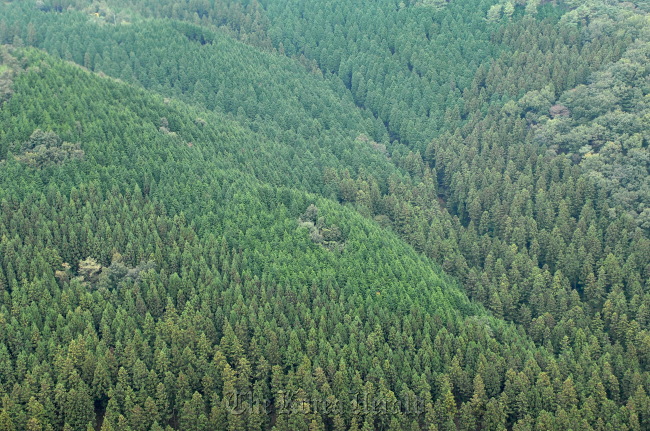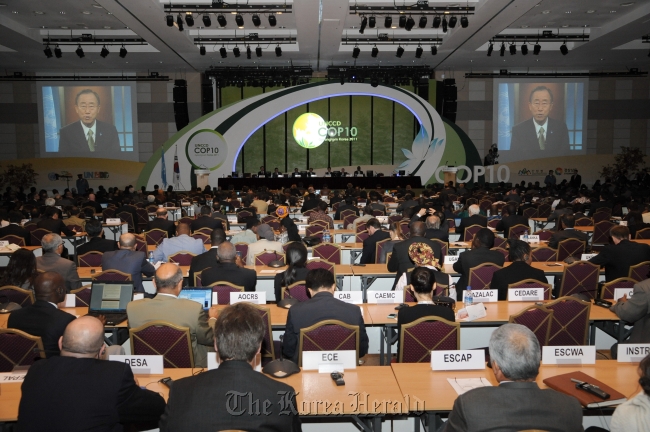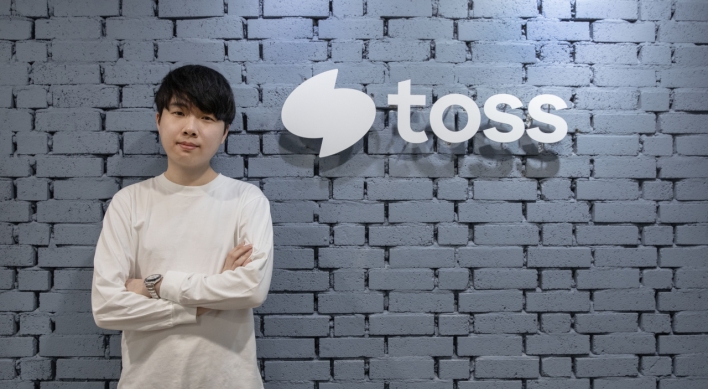
Forestation is important to every country, as green spaces give people a number of benefits, such as clean air, food and medicinal resources, and increased biodiversity, as well as carbon dioxide absorption and water source protection.
Korea has worked to green up its open spaces for the past 40 years and its reforestation policy has been looked on as a benchmark for countries seeking rapid reforestation.
Evolution of forestry policy
Korea’s forests cover 64 percent of its land area today, but 40 years ago there was very little woodland. Excess cutting and exploitation during and after the Japanese occupation and the Korean War devastated the forests. Despite the deteriorating conditions, the whole nation and its people made collective efforts to reverse and rehabilitate degraded forests from the 1970s. Compared to the status of forests in 1970, forest resources have increased today by 11 times, and the stock has grown from 10 to 126 cubic meters.
This successful forest rehabilitation has been achieved through sustainable forest management which can work as a green growth model for countries suffering from forest degradation.
This achievement is attributed to government-initiated policy on forest conservation and plantation and participation of the public.
Korea has worked to green up its open spaces for the past 40 years and its reforestation policy has been looked on as a benchmark for countries seeking rapid reforestation.
Evolution of forestry policy
Korea’s forests cover 64 percent of its land area today, but 40 years ago there was very little woodland. Excess cutting and exploitation during and after the Japanese occupation and the Korean War devastated the forests. Despite the deteriorating conditions, the whole nation and its people made collective efforts to reverse and rehabilitate degraded forests from the 1970s. Compared to the status of forests in 1970, forest resources have increased today by 11 times, and the stock has grown from 10 to 126 cubic meters.
This successful forest rehabilitation has been achieved through sustainable forest management which can work as a green growth model for countries suffering from forest degradation.
This achievement is attributed to government-initiated policy on forest conservation and plantation and participation of the public.

The government created the Korea Forest Service in 1967 and after legal and institutional preparations, the KFS initiated the 10-year forest rehabilitation plan starting in 1973. The first national forest plan, which was launched in 1973, aimed to restore denuded forest, so the government encouraged the public to plant fast-growing trees, declaring a nationwide tree planting period from March 21-April 20 every year.
The fifth national forest plan, the latest government-driven forestation initiative, which runs until 2017, sets the goal of further implementing sustainable forest management in pursuit of maximizing forest function. In particular, the plan highlights the importance of forest functions in responding to climate change. The overall vision of the fifth plan is “to realize a green nation with sustainable welfare and growth” by sustainably managing forests as key resources for strengthening national economic development, land conservation and improved quality of life.
Enhancement of international forestry cooperation
Korea’s rapid reforestation has brought worldwide recognition. The Food and Agriculture Organization of the United Nations credited the achievements, and Lester Brown, a well known environmental journalist, hailed Korea’s reforestation as a model for the world in his book titled Plan B.
Boosted by its global recognition as a green growth model nation, Korea is working to foster global cooperation to share valuable experience from its forest rehabilitation projects.
In line with the effort to enhance international cooperation, Korea hosted the 10th session of the Conference Parties of the United Nations Convention to Combat Desertification in Changwon, South Gyeongsang Province, in October, 2011.
The participants of the conference adopted the Korea-led Changwon Initiative for combating desertification, mainstream desertification, land degradation and drought issues and to establish an international forestry cooperation partnership.
Korea also initiated the establishment of the Asian Forest Cooperation Organization, or AFoCO, the first international organization specializing in forest issues and technology in Asia last year during the Special ASEAN-Korea Ministerial Meeting held from Aug. 29-30 in 2012.
Adoption of Korean reforestation model
China benchmarked Korea’s reforestation cases and initiated its green growth plan to block yellow dust from inner Mongolia by 2050. The tree belt it has planted is longer than 4,900 kilometers.
The Mongolian government is pushing forward its 30-year national reforestation project. It is one the Korean government is deeply engaged in. Since 2007, efforts to suggest successful ways to prevent Mongolian desertification, such as planting trees, establishing tree nurseries and education centers, having joint research and transferring technologies have been under way.
These efforts have led the Mongolian government to establish the Forestry Agency and designate every second Saturday in May and October as Arbor Day, to encourage its people to participate in events such as planting trees. Cooperation among diverse participants including the KFS and NGOs from many other countries are critical success factors. In addition, KFS is making diverse efforts to take measures about enhancing science and technology related to forestation, promoting dry-land partnerships and establishing the Land for Life Award.
It also supports AFoCO to help its member countries, mainly from Southeast Asia for now, to manage and conserve forests. It also tries to give the organization diverse suggestions such as supporting resources, improving human resources and promoting cooperation.
By Seo Jee-yeon (jyseo@heraldcorp.com)
-
Articles by Korea Herald



![[AtoZ into Korean mind] Humor in Korea: Navigating the line between what's funny and not](http://res.heraldm.com/phpwas/restmb_idxmake.php?idx=644&simg=/content/image/2024/04/22/20240422050642_0.jpg&u=)


![[Herald Interview] Why Toss invited hackers to penetrate its system](http://res.heraldm.com/phpwas/restmb_idxmake.php?idx=644&simg=/content/image/2024/04/22/20240422050569_0.jpg&u=20240422150649)
![[Graphic News] 77% of young Koreans still financially dependent](http://res.heraldm.com/phpwas/restmb_idxmake.php?idx=644&simg=/content/image/2024/04/22/20240422050762_0.gif&u=)



![[Exclusive] Korean military set to ban iPhones over 'security' concerns](http://res.heraldm.com/phpwas/restmb_idxmake.php?idx=644&simg=/content/image/2024/04/23/20240423050599_0.jpg&u=20240423171347)




![[Exclusive] Korean military to ban iPhones over security issues](http://res.heraldm.com/phpwas/restmb_idxmake.php?idx=652&simg=/content/image/2024/04/23/20240423050599_0.jpg&u=20240423171347)



![[Today’s K-pop] Ateez confirms US tour details](http://res.heraldm.com/phpwas/restmb_idxmake.php?idx=642&simg=/content/image/2024/04/23/20240423050700_0.jpg&u=)